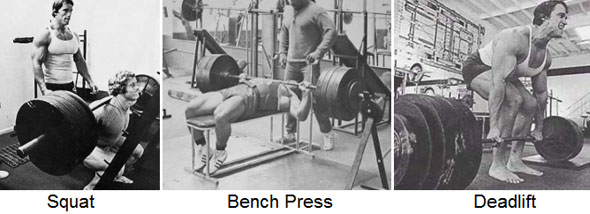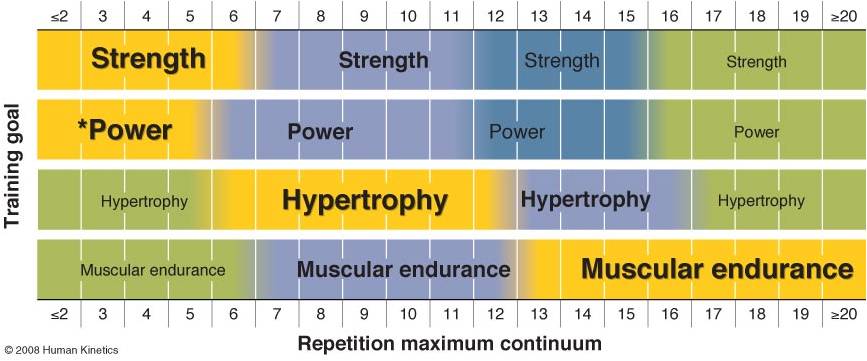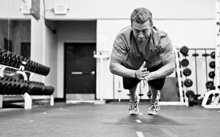I recently recieved an email from a 1RM Perfomance follower asking some good questions about training and nutrition. Throughout the week, I will be sharing the answers with you guys one at a time.
Enjoy!
What types of workouts (sets/reps) are most beneficial for gaining muscle and strength for the main lifts like bench, squat, deadlift? What Pertange of my max should I be doing with each set?
I always say, if you want to be strong at the big 3 lifts, train the big three lifts. I'm a big fan of specificity, it is simple and it works.

In terms of the most beneficial training program for improving your numbers of the big three, I have found that two 40-day cycles of 3 training days, over 6 days to be the most beneficial. Over the first 40 days, volume and intensity are both increasing. During the second 40 day cycle volume is kept relatively low while intensity continues to increase.Below is an example of a 6 day cycle during the moderate and low volume cycles.
| Day | Exercise | Reps x Sets | Weight/% 1rm | Day | Exercise | Reps x Set | Weight/% 1rm | |
| 31 | Bench | 6x5 | 320 | 51 | Bench | 2x3 | 350 | |
| Squat | 2x5 | 360 | Squat | 2x5 | 380 | |||
| 33 | Deadlift | 6x5 | 470 | 53 | Deadlift | 3x3 | 515 | |
| 36 | Squat | 6x5 | 390 | 56 | Squat | 3x3 | 430 | |
| Overload Squat | x3 | 545 | Overload Squat | x3 | 570 | |||
| Bench | 2x5 | 305 | Bench | 2x5 | 310 |
The Effect of Stress on Your Exercise Program
When I followed this training program, I found my shirt and pants getting tighter. The reason for this growth wasn't due to the program per say, but more a result of maintaining my normal dietary habits, expending less calories in the gym, and decreasing my activity outside of the gym. My goal during this training program was to get as strong as possible. In order to do so, I made sure I was fully recovered and didn't let anything get in the way of my training.
Being 26 years old and having minimal stress allows you to do this. However, that isn't the same for everyone.
Muscle growth and increases in strength are dependent upon multiple factors, the most important being your ability to understand and mitigate your stressors. In other words, do you understand and recognize all the different aspects of your life that impact your overall stress level? If you are a young athlete and have a batting coach, pitching coach, team practices 2x a week, AND work with a strength coach, odds are your strength coach won't be able to have as great of an impact as he would like. If you have a high stress job, stay up late working on projects, have kids to take care of, poor eating habits and a marriage to maintain, odds are you to will be hard pressed to make any quick gains at the gym. (More of this to come!)
What Percentage of my max should I be doing with each set?
The easiest way to set a guideline for % 1RM is with the Repetition maximum continuum (NSCA guidelines).

I feel that it is hard to follow a certain percetage of your 1rm for each set throughout a training cycle. Your 1RM can be used as a gauge, or daily bench mark, however, I believe it will be imposisible for someone to hit every lift they are suppose to hit.
An exception to the rule comes in the world of professional athletes. If your job is to be an athlete, your life is training. When your life is training, it is easier to control your stress and train when your body is ready to train.
With that said, there are certain guideline that you can follow to help gauge and maintain overload throughout your training program.
1. Keep a training log.
This will help you stay on track and maintain a training program. It is very hard to remember your reps, sets, and weight, over a month long period. Take a minute, write down the details, and watch your progress unfold before your eyes.
2. Keep in mind of the reps and set you want to hit for that day.
In this case, finding your initial 1RM, and a selected precentage can be a benefit during yoru training cycle. We all go into a set with a certain number of reps in mind. A trip to a local gym will show you people who drastically undershoot the weight they can do for a given repetition goal.
Just last week, I was lucky enough to spot a kid on flat dumbbell bench press. He asked for a spot during his set of 4 with 105lb DBs. He cranked them out pretty easy so I suggested a heavier set with 110lb DBs for 4. He cranked them out without any help. He then proceeded to do every chest exercise imaginable for the next 60 minutes. His first heavy sets of flat bench were productive; his next hour of chest, probably not productive. In this situation, having an idea of your 1RM could have given the kid a better idea of what he should be lifting.
3. Do NOT always train until failure

Training until failure, as previously discussed in Overtraining and The Bulgarian Squat Routing, is a sure fire way to lead to overtraining. This will halt your progress and will eventually result in regression in your training. Not to mention with each rep, you are fatiguing your central nervous system more and more. In other words, your forms is fading with each passing rep, increasing your risk of injury.
Instead of pushing to failure, try a cluster set. What is a cluster set? While doing a set, you take a short break in the middle of the set and then finish the set. For example, if you were doing a set of 4 at 93% or your 1rm, you would do 2 reps, rest 30 seconds, and then finish your final 2 reps. The literature has shown this could be more effective then a traditional set when it comes to improving your 1rm. Reason being? The slight break, whether it is 20, 30, or 40 seconds is enough to allow your CNS to slightly recover. It keeps your speed of the bar up and helps to maintain power through the whole range of motion. There will be more on this to come in the next few weeks.
Take Home Messages
In the grand scheme of things Specificity wins over all. If you want to have a higher 1 RM for the big three lifts, train the big three lifts.
Following percentages through a training program is difficult if your life involves more then training. Use them as a guideline or reference for that days workout.
The greatest exercise program in the world won't help if it doesn't fit your lifestyle. The key is understanding the stress in your life. When you can do that, training gets a lot easier.
Track your progress! If you really want to follow a program, you have to see what you did last workout!
Stay tuned, round two of questions comes tomorrow!


